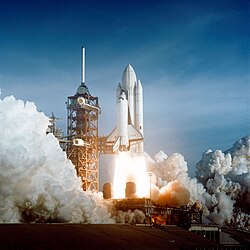STS-48
| Missionsemblem | |||
|---|---|---|---|
 | |||
| Missionsdaten | |||
| Mission | STS-48 | ||
| NSSDCA ID | 1991-063A | ||
| Besatzung | 5 | ||
| Start | 12. September 1991, 23:11:04 UTC | ||
| Startplatz | Kennedy Space Center, LC-39A | ||
| Landung | 18. September 1991, 07:38:42 UTC | ||
| Landeplatz | Edwards Air Force Base, Bahn 22 | ||
| Flugdauer | 5d 8h 27m 38s | ||
| Erdumkreisungen | 81 | ||
| Umlaufzeit | 95,4 min | ||
| Bahnneigung | 56,9° | ||
| Apogäum | 553 km | ||
| Perigäum | 538 km | ||
| Zurückgelegte Strecke | 3,5 Mio. km | ||
| Nutzlast | UARS | ||
| Mannschaftsfoto | |||
 v. l. n. r. Mark Brown, Charles Gemar, John Creighton, James Buchli, Kenneth Reightler | |||
| ◄ Vorher / nachher ► | |||
| |||
STS-48 (englisch Space Transportation System) ist eine Missionsbezeichnung für das US-amerikanische Space Shuttle Discovery (OV-103) der NASA. Der Start erfolgte am 12. September 1991. Es war die 43. Space-Shuttle-Mission und der 13. Flug der Raumfähre Discovery.
Mannschaft
- John Creighton (3. Raumflug), Kommandant
- Kenneth Reightler (1. Raumflug), Pilot
- James Buchli (4. Raumflug), Missionsspezialist
- Charles Gemar (2. Raumflug), Missionsspezialist
- Mark Brown (2. Raumflug), Missionsspezialist
Missionsüberblick
Der Start erfolgte am 12. September 1991. Er hatte sich um 14 Minuten verzögert aufgrund eines Kommunikationsproblems zwischen dem Kennedy Space Center und der Missionszentrale in Houston. Das Startgewicht betrug 108.890 kg.
Die Hauptnutzlast, der Upper Atmosphere Research Satellite (UARS), wurde am dritten Flugtag (MET 2/05:12) ausgesetzt. Der 6,5 Tonnen schwere Satellit führte eine der detailliertesten Studien der Erdatmosphäre durch und erforschte im Rahmen der internationalen Mission zum Planeten Erde die Troposphäre und maß dabei u. a. Ozonkonzentration, Windgeschwindigkeiten sowie solare und interstellare Strahlung.
Weitere Shuttle-Nutzlasten waren: Ascent Particle Monitor (APM); Middeck 0-Gravity Dynamics Experiment (MODE); Shuttle Activation Monitor (SAM); Cosmic Ray Effects and Activation Monitor (CREAM); Physiological and Anatomical Rodent Experiment (PARE); Protein Crystal Growth II-2 (PCG II-2); Investigations into Polymer Membrane Processing (IPMP) und das Air Force Maui Optical Site (AMOS) Experiment.
Die Landung erfolgte am 18. September um 7:38 Uhr UTC auf Landebahn 22 der Edwards Air Force Base in Kalifornien. Es war die fünfte Nachtlandung des Shuttle-Weltraumprogrammes. Die Landung war ursprünglich im Kennedy Space Center vorgesehen, aber wegen Schlechtwetters nach Edwards verlegt worden. Der Orbiter kehrte am 26. September nach Florida zurück. Das Landegewicht betrug 87.444 kg.
Siehe auch
Weblinks
- NASA-Missionsüberblick (englisch)
- Videozusammenfassung mit Kommentaren der Besatzung (englisch)
- STS-48 in der Encyclopedia Astronautica (englisch)
Auf dieser Seite verwendete Medien
The April 12 launch at Pad 39A of STS-1, just seconds past 7 a.m., carries astronauts John Young and Robert Crippen into an Earth orbital mission scheduled to last for 54 hours, ending with unpowered landing at Edwards Air Force Base in California.
The STS-48 crew portrait includes (front row left to right): Mark N. Brown, mission specialist; John O. Creighton, commander; and Kenneth S. Reightler, pilot. Pictured on the back row (left to right) are mission specialists Charles D. (Sam) Gemar, and James F. Buchli. The crew of five launched aboard the Space Shuttle Discovery on September 12, 1991 at 7:11:04 pm (EDT). The primary payload of the mission was the Upper Atmosphere Research Satellite (UARS).
STS-48 Mission Insignia
- Designed by the astronaut crewmembers, the STS 48 patch represents the Space Shuttle Orbiter Discovery in orbit about the Earth after deploying the Upper Atmospheric Research Satellite (UARS) depicted in block letter style. The stars are those in the Northern Hemisphere as seen in the fall and winter when UARS will begin its study of Earth's atmosphere. The color bands on Earth's horizon, extending up to the UARS spacecraft, depict the study of Earth's atmosphere. The triangular shape represents the relationship among the three atmospheric processes that determine upper atmospheric structure and behavior: chemistry, dynamics and energy. In the words of the crewmembers, This continuous process brings life to our planet and makes our planet unique in the solar system."



